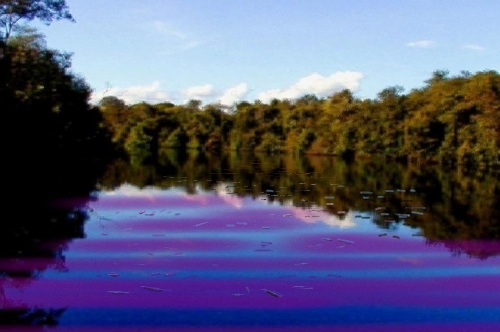BY LETTER
Algaehol Bloom Disaster, The
History > 0030 to 0900 AT: Solsys Era
Science > Biology > Ecology
Technology > Technology Type or Material > Gengineering
Technology > Application > Power Generation
Science > Biology > Ecology
Technology > Technology Type or Material > Gengineering
Technology > Application > Power Generation
Early genetic engineering causes an ecological catastrophe | |
 Image from Steve Bowers | |
| The poisoned waters of the Amazon were covered in a biodiesel slick | |
During the Early Information Age, the population of Earth derived most of its energy from fossil fuels, usually coal or oil. The Earth's supply of fossil fuels was eventually exhausted, leaving a world starving for energy. Nuclear reactors, both fission and (later) fusion were in widespread use, as were solar, wind and tidal-generated electricity, and Ocean Thermal Energy Conversion. However technologies to store and transmit electrical energy were not compatible with the infrastructure already in place to deliver fossil fuels. A new energy technology was required, preferably one that could be distributed like the liquid hydrocarbon fuels already in use.
One of the most successful was a big breakthrough in the field of bionanotech and genegineering. A kind of algae was gengineered, with symbiotic bionanotechnology that, in a complicated, multistage process turned gases readily available in the air, sunlight, and water into ethyl alcohol, fatty acids suitable for conversion into "biodiesel", and free oxygen. This gengineered aquatic plant and symbiotic bionano system was farmed in huge tracts of land, usually on upright frames that would have water piped in to the top of the plant that would wash down over the plant, carrying away the ethyl alcohol. After some time, the plant would be harvested and converted to biodiesel.
A century or more before the Technocalypse - the exact timing is unknown - reports of wild infestations of this algae were reported around the world. It had been gengineered to be hardy, vigorous and resistant to pests and herbivores - due mostly to the presence of concentrated ethyl alcohol, and because of that, local indigenous flora and fauna couldn't compete with it once a sample went "feral". The algaehol organism was particularly well equipped to live in rain forest conditions and near, or in, lakes and rivers.
It is estimated that over 90% of the landmass in Vietnam and Laos were covered by this algae in but a single year. Outbreaks in Africa were less widespread, however most of the Amazon Basin was covered when an algae farm and fuel processing plant at the headwaters of the Amazon suffered a terrorist attack that left the site unattended for 30 hours. Over the next few months, algal blooms were found along the length of the Amazon. A few months after that, most of the indigenous fish of that river were dead. Whether the terrorist attack on the processing facility was intended to release the algae and create an ecological disaster, or if the effect was incidental is unknown at this point.
Many of the ethyl alcohol producing gengineered plants in modern times can trace their origins back to this algae, and are directly derived from it.
Related Articles
- Energy - Text by M. Alan Kazlev
The capacity for doing work. Energy can change from one form (heat, chemical, nuclear, potential energy) to another but is always conserved. In amat, magmatter catalyzed, and nuclear reactions, mass can be converted into energy. - Gengineer, Geneer (profession)
Appears in Topics
Development Notes
Text by ROM 65536
Initially published on 22 May 2006.
Initially published on 22 May 2006.






